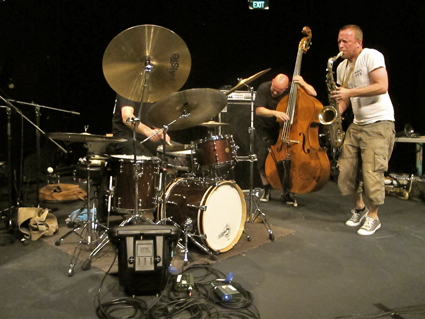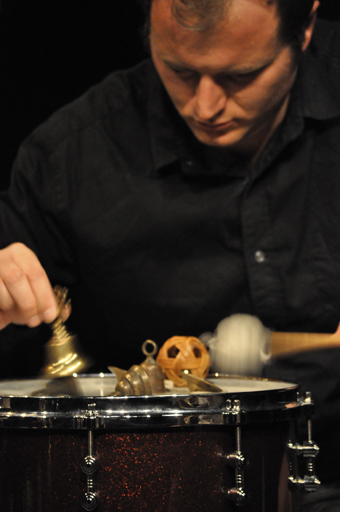pure pursuits
gail priest: soundout 2011, canberra

The Thing, SoundOut 2011
photo Yasmin Masri
The Thing, SoundOut 2011
SOUNDOUT IS THE NEW-KID-ON-THE-FESTIVAL-BLOCK, BUT BY NO MEANS UNFORMED IN TERMS OF AGENDA. WHILE OTHER FESTIVALS MAY NOW TAKE IN INFLUENCES FROM A RANGE OF MUSICS WITH EXPERIMENTAL FRINGES (POP, FOLK, BEATS), SOUNDOUT DIRECTED BY RICHARD JOHNSON, IS UNCOMPROMISING IN ITS PURE PURSUIT OF MUSIC IN THE MOMENT, SOUGHT THROUGH FREE JAZZ AND IMPROVISATION.
Johnson has established a rigorous structure in which 20 artists play in a range of groupings for a total of 16 hours over two days. If you attended the entire festival (which I, the artists, and a few dedicated punters did) you were treated to seeing the same people perform up to five times. The original programming, promising 40-minute sets with 8-minute turnaround times, quickly proved impractical as artists felt they needed to play for as long or (as was more often the case) as briefly as felt right—and thankfully some shorter sets allowed the audience to take a break. So while the event felt a little like an endurance test, there were many rewarding moments of which the following are but a few.
It was a joy to witness another instalment of the Great Waitress—Magda Mayas (Germany), Monica Brooks and Laura Altman. I saw them first at the 2009 NOW Now festival (RT89) and really appreciated their intense, quiet focus. This time they were louder and more forceful, Brooks on accordion producing fat humming drones, Altman on clarinet interjecting with high tones and overblows while Mayas, with her hands in the instrument, pulled strings attached to piano wires to create long, slow glissandi and big bent notes, evoking a Fellini-esque circus ambience.
Saxophonists Jim Denley and Rosalind Hall re-arranged the room to sit facing each other across a table set amid the audience. While Hall explored timbral shifts over long tones by placing a variety of objects into the bell of her saxophone, Denley, augmenting the mouthpiece of his sax with his trusty balloon extension, worked more with rhythm and phrasing. Their searchings around each other’s sounds created the sense of a challenging, yet cheeky conversation.
A playful approach also characterised a collaboration between Cor Fuhler (Germany), Dale Gorfinkel and Kim Myhr (Norway). Fuhler generated startling harmonics with magnets and ebows and then set toys crawling over the strings, while Myhr bowed ancient fairy tones from a zither. Gorfinkel added and subtracted bits from his trumpet/trombone hybrid, augmented with tubing and extra motors on which he placed spinning bits of styrofoam, his instrument strangely reminiscent of a platypus in its mismatched wonder. The overall combination of rich drones, agitated pizzicatos and friction squeals was as joyous as it was unique.
Late on the Sunday afternoon a primal drumming sequence from Gorfinkel and James Waples, with stuttered, broken chords from Brooks on piano, kicked in before the audience had come back from a break, creating a sense that we were welcome but not necessary to the proceedings: this was purely an exploration for the musicians themselves. After the initial energy burst of drumming fell away, Brooks busied herself running a glass over the strings of the piano; Waples explored a scratching sequence over his kits including cymbal spinning; and, after a long period of non-participation, Gorfinkel explored a tapping sequence on his trumpet. It was the purest set of the festival in its unabashed pursuit of sound-making actions with less concern as to how these might be shaped to appeal to an audience. It was a kind of crumbly music, with no binding principles beyond the authenticity of the actions themselves—a thought provoking session that had me pondering the tensions between process and presentation in improvisation.
The most invigorating shake-up was experienced in the blistering power jazz of The Thing (Norway/Sweden). With the bravado of stadium rock the trio delivered a sustained high-energy set—a seemingly endless stream of notes and complex rhythmic interplay crashing, clashing and sometimes combining. Occasionally it resolved into merely medium-energy free jazz, the saxophonist Mats Gustavsson treating us to fragments of nostalgic melody while the bass player Ingebrigt Håker Flaten generated warm fuzzy feedback hum through his amplifier until the drummer, Paal Nilssen-Love could no longer rein in his need to go faster, harder and louder and the band exploded, again—all orgasm faces and forces. The trio was joined by Tony Buck, also on drums, Mayas on piano and Mike Majkowski on bass and The Thing pulled back politely, creating something of a harmonic field over which the others added angular and pointillist elements.

Isaiah Ceccarelli, SoundOut 2011
photo Yasmin Masri
Isaiah Ceccarelli, SoundOut 2011
However the most surprising turn in events came in the 16th set (out of 20) of the festival with Denley and Richard Johnson on woodwinds and Evan Dorrian and Canadian artist Isaiah Ceccarelli on drums. Ceccarelli had been an intriguing presence, often sustaining an action through long sections of a set, providing a sense of consistency while others swirled around him. In this instance, after exploring the running of bells across his drum, he suddenly burst into song! In a beautiful baritone he executed interval leaps and chants, creating an improv opera that was playful, profoundly beautiful and surprising, energising everyone, most of all, perhaps, his fellow musicians.
Moments like Ceccarelli’s poetic outpouring and Gorfinkel/Waples/Brooks’ ‘crumbly music’ were interesting responses to the intensity otherwise generated by the SoundOut format. (Yan Jun from China on delicate handmade electronics and Monica Brooks on accordion also sought extremes in their exactingly minimalist set in which the in-house cricket was decibels louder than their output.) It was fascinating to watch musicians discover that some of their tactics were exhausted by their fifth appearance, forcing them to push further to find new methods of engagement with their own instruments and with the group. Experiencing all the SoundOut sessions was not for the faint-hearted, but the compression certainly brought something out in the musicians: this energy was felt by audiences attending even a single session. While the NOW now festival (page 38) covers a similar improv remit, it encourages a little more cross-genre play and is more spacious, spread over several evenings. The crazy intensity of the work-day units of SoundOut, its purity of focus and its location in our nation’s capital offer it genuine points of difference.
SoundOut 2011, director Richard Johnson, artists Cor Fuhler, Dale Gorfinkel, Evan Dorrian, Jim Denley, Kim Myhr, Laura Altman, Magda Mayas, Michael Norris, Mike Majkowski, Monika Brooks, Richard Johnson, Rosalind Hall, Shoeb Ahmed, The Thing (Mats Gustafsson, Ingebrigt Haker-Flaten, Paal Nilssen-Love), Tony Buck, Isaiah Ceccarelli, James Waples, Yan Jun; The Street Theatre, Canberra, Jan 29-30
RealTime issue #102 April-May 2011 pg. 39






